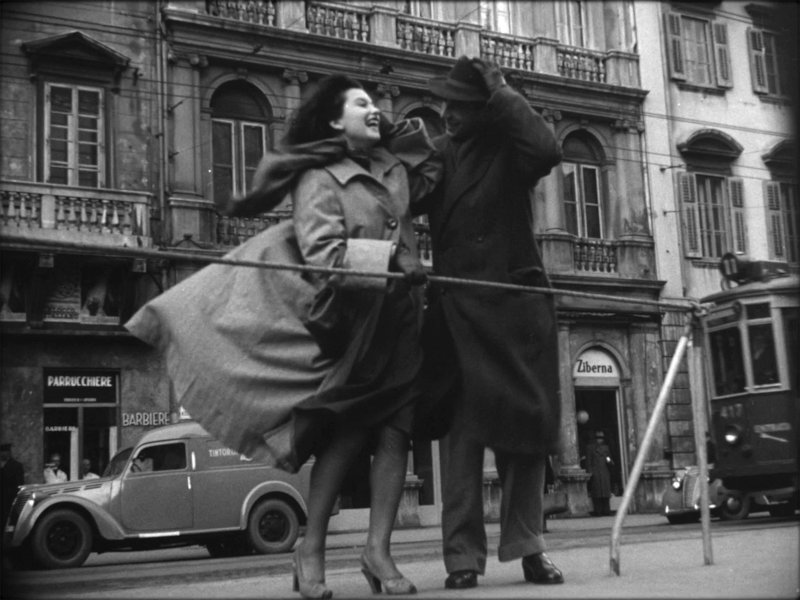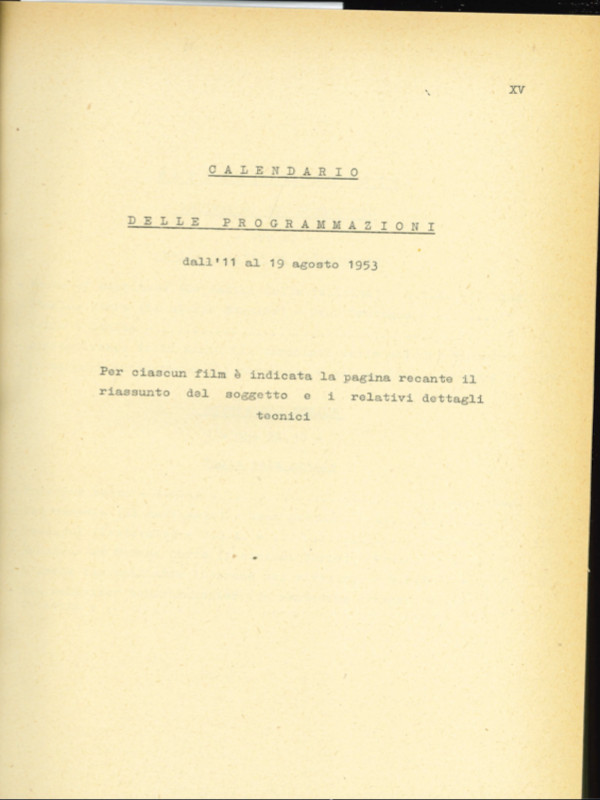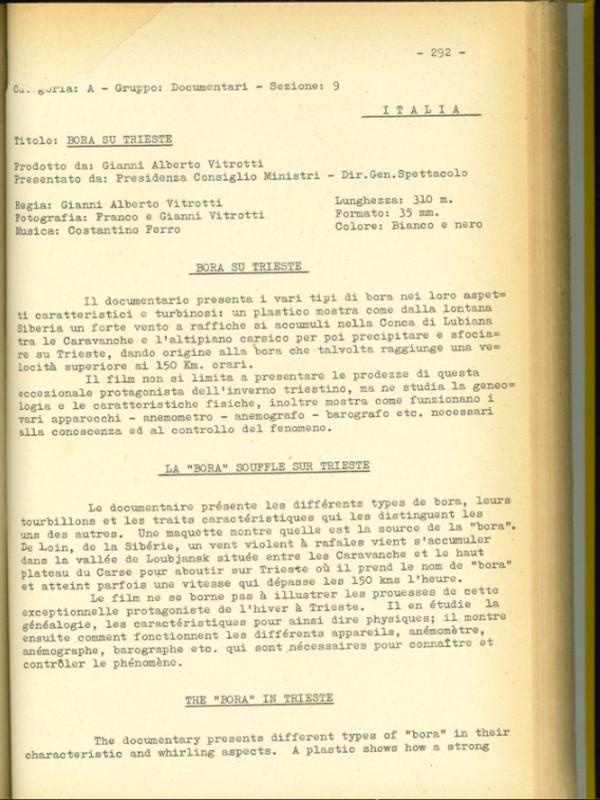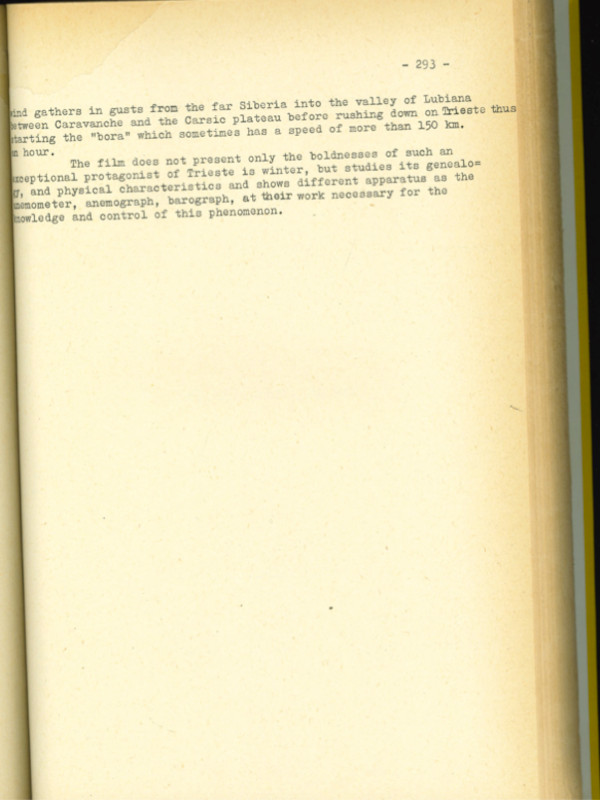Bora over Trieste (1953)
Bora su Trieste [ITA]
Scenes from the port town of Trieste during winter, when the bora, a strong northerly wind that is characteristic of this city, is blowing at full capacity.
- Film kind: documentary, short
- Duration: 12’
- Year: 1953
- Country: ITA
- Format: 35 mm, black and white
- Language: Italian
- Director: Gianni Alberto Vitrotti
- Director’s assistant: Franco Biamonti
- Cinematography: Gianni Alberto Vitrotti, Franco Vitrotti
- Editing: Mario Sansoni
- Music: Costantino Ferri
- Comment by: Giovanni Tessaro
- Production: Lux film [ITA]
- Restored copy available at: Cineteca del Friuli [ITA]
- Film festivals: Venice Film Festival [ITA] (1953), Trieste Film Festival (2018)
- Other screenings: Special screening dedicated to Gianni Alberto Vitrotti [ITA], curated by Valentino Vitrotti (Palazzo Gopcevich, Trieste, October 3, 2019); traveling conference Oriente-Occidente: la frontiera nel cinema e nella storia, 1945-1954-2025 [ITA], screening and lecture "The Cinematic Battle for the Adriatic - Films, Frontiers and the Trieste Crisis" [SLV] (Slovenska kinoteka, Ljubljana, May 11, 2022).
- Awards: Silver Lion for in the category of documentary films, Venice Film Festival, 1953 [Premio per la Categoria A - Gruppo Documentari - Sezione 9 - documentari di attualità, 1953]
Videogallery
Photogallery
Film stills
Programme of the Venice Film Festival 1953
“Bora over Trieste” in the programme of the Venice Film Festival, 1953. Courtesy of La Biblioteca della Biennale di Venezia.
Long synopsis
This short documentary shows everyday life in Trieste from 1951 to 1953, with scenes featuring the strong north wind known as ‘Bora’, one of Trieste’s hallmarks. It took more than three years to complete it due to difficult meteorological conditions – at soe points the wind was blowing at speeds of up to 100 km/h. At first glance, the film may appear to be just a meteorological story. However, it actually has political significance because amid the conflict with Yugoslavia, it depicts Trieste’s history and daily life emphasizing the town’s Italian character.
Festival circulation
“Bora over Trieste” achieved its biggest festival success in 1953 when it was shown at the Venice Film Festival and awarded with the Silver Lion in the group of documentaries on social problems and achievements (1953). This screening happened at the height of tensions with Yugoslavia over the status of Trieste, when the diplomatic crisis was almost turned into an armed conflict. (Tito delivered his famous speech about the deterioration of the Trieste Crisis at a mass rally in the village of Okroglica, just next to the border, only a few days later, on September 6, 1953.)
In the contemporary context, “Bora over Trieste” was shown at the Trieste Film Festival’s closing in 2022. It had an excellent screening slot right after the award ceremony. It has also been a part of various events dedicated to filmmaker Gianni Alberto Vitrotti, as for instance a special programme curated by his son Valentino Vitrotti [ITA] on October 3, 2019 in Palazzo Gopcevich in Trieste. It was also screened withing the traveling conference Oriente-Occidente: la frontiera nel cinema e nella storia, 1945-1954-2025 [ITA]. At this occasion it was shown together with a selection of Yugoslav and Italian short documentaries within the lecture "The Cinematic Battle for the Adriatic - Films, Frontiers and the Trieste Crisis" [SLV] (Slovenska kinoteka, Ljubljana, May 11, 2022).
Media and public interest
In the contemporary context, the film has been gaining more and more attention in the public space, due to an increased interest in the issue of the Northern Adriatic borderlands. On April 14, 2020 it was uploaded for online viewing [ITA] by Cineteca del Friuli [ITA].
About the filmmaker
Gianni Alberto Vitrotti (1922-2009) was the most prominent cinematographer who captured the events associated with the Italian-Yugoslav conflict over the Northern Adriatic borderlands. He was the first cameraman who filmed the exhumations of the bodies from the sinkholes [ITA] (the “foibe” massacres) and the emigration of Italians from the areas annexed by Yugoslavia. He began his involvement in filmmaking at the age of 17 by working alongside his father, Giovanni Vitrotti, one of the pioneers of Italian silent cinema. After the war, he settled in Trieste, where he worked as a photojournalist and cameraman for various American agencies and companies, including Associated Press Photo, NBC, Universal Film Newsreel from New York, but also the Allied Military Government. In this period, together with his brother Franco, he filmed numerous documentaries and newsreels about the situation in the borderlands, including Enrico Moretti’s documentaries “Giustizia per la Venezia Giulia” (1946), “Campane a morto in Istria” (1947), and “Pola, addio” [ITA] (1947). He died in Trieste in 2009, at the age of 87.
NB: For the film’s analysis, see the article “The Cinematic Battle for the Adriatic: Film Festivals and the Trieste Crisis”, and, specifically, pages 58-59 ("Cinergie – Il cinema e le altre arti", N. 22 University of Bologna, 2022, pp. 55-68).







